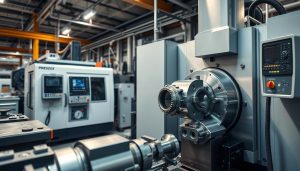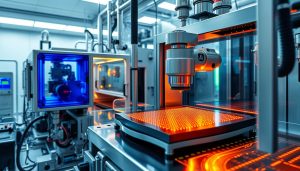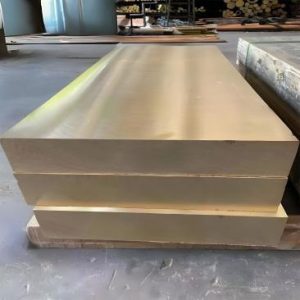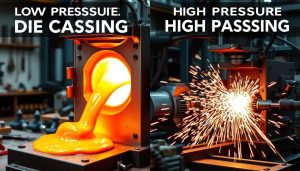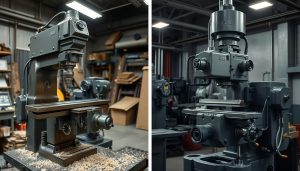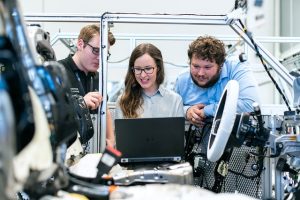In the rapidly evolving world of manufacturing, the demand for precision and miniaturization has become increasingly paramount. Micromachining, a transformative technology, has emerged as a game-changer, unlocking new possibilities in the realm of computer numerical control (CNC) machining. This innovative approach to microscale production is revolutionizing industries by enabling the creation of intricate, high-precision parts that were once considered impossible to achieve through conventional machining methods.
At the heart of micromachining lies the seamless integration of advanced tooling, specialized software, and precise control systems. This powerful combination allows manufacturers to tackle the challenges of producing small-scale components with unparalleled accuracy and repeatability, opening up new frontiers in product design and performance.
What is Micromachining?
Micromachining is a specialized subfield of precision manufacturing that focuses on the fabrication of small-scale components and features. This advanced technique enables the production of highly intricate parts at the microscale level, making it a crucial tool in industries where miniaturization and tight tolerances are paramount.
Definition and Basic Principles of Micromachining
Micromachining can be defined as the process of using miniaturized cutting tools, high-precision machinery, and advanced control systems to create microscale features and components. The basic principles of micromachining involve the controlled removal of material from a workpiece to achieve the desired shape, size, and surface finish at the micrometer or sub-micrometer scale.
Key Differences Between Micromachining and Traditional CNC Machining
- Scale: Micromachining operates at the microscale, handling parts and features that are significantly smaller than those produced by traditional CNC machining.
- Tolerances: Micromachining requires the ability to achieve tighter tolerances, often in the range of a few micrometers or less, compared to traditional machining.
- Tooling: Micromachining utilizes specialized cutting tools that are significantly smaller and more precise than those used in conventional CNC machining.
- Control Systems: Micromachining requires advanced control systems and computer-aided manufacturing (CAM) software to precisely manage the movements and parameters of the cutting tools.
- Materials: Micromachining is often used with harder and more challenging materials, such as ceramics, glasses, and advanced composites, which require specialized techniques and tools.
By understanding the definition and key differences between micromachining and traditional CNC machining, manufacturers can better appreciate the unique capabilities and challenges associated with this advanced precision manufacturing technique.
“Micromachining is the enabler for the miniaturization and mass production of high-precision components that are essential for modern electronics, medical devices, and other advanced technologies.”
The Role of Micromachining in Precision Manufacturing
Precision manufacturing is the cornerstone of modern industrial innovation, and micromachining plays a pivotal role in this crucial domain. By leveraging advanced techniques, micromachining enables the production of intricate, miniaturized components that are essential for a wide range of industries, from electronics to medical devices.
Benefits of Micromachining for Small Parts Production
One of the key advantages of micromachining is its ability to deliver exceptional precision and accuracy in the production of small parts. This technology allows manufacturers to create complex geometries and features with unparalleled precision, catering to the growing demand for smaller, more compact products.
- Micromachining facilitates the fabrication of components with tolerances in the micrometer and sub-micrometer ranges, ensuring a level of precision that is simply unattainable through traditional machining methods.
- By leveraging advanced cutting tools and precise control systems, micromachining enables the production of intricate features, such as micro-channels, micro-holes, and micro-structures, that are essential in a wide range of applications.
- The superior dimensional accuracy and surface quality achieved through micromachining processes contribute to improved product performance and reliability.
How Micromachining Improves Product Quality and Performance
Beyond its role in small parts production, micromachining also plays a crucial part in enhancing overall product quality and performance. By pushing the boundaries of traditional manufacturing, this technology unlocks new possibilities for product design and functionality.
| Micromachining Benefit | Impact on Product Quality and Performance |
|---|---|
| Improved Dimensional Accuracy | Ensures tight tolerances, reduced wear, and enhanced functionality |
| Enhanced Surface Finishes | Minimizes friction, wear, and corrosion for improved product lifespan |
| Capability for Complex Geometries | Enables the creation of innovative designs with improved performance characteristics |
By harnessing the power of micromachining, manufacturers in precision-driven industries can elevate their products to new levels of quality and performance, ultimately delivering greater value to their customers.

Types of Micromachining Techniques
In the world of precision manufacturing, micromachining techniques play a crucial role in pushing the boundaries of what’s possible. From micro milling to micro turning and electrical discharge machining (EDM), these advanced processes unlock a new realm of capabilities for creating intricate small-scale components. Let’s delve into the specifics of these micromachining techniques and explore their unique advantages.
Micro Milling: Precision and Versatility
Micro milling is a highly precise subtractive manufacturing process that utilizes miniature cutting tools to shape and sculpt materials at the microscale. With tool diameters as small as 0.1 mm, micro milling enables the creation of complex geometries, intricate features, and tight tolerances that are simply unachievable through traditional CNC machining. This technique finds widespread applications in the electronics, medical, and aerospace industries, where the demand for high-precision, small-scale parts is ever-increasing.
Micro Turning: Achieving Unparalleled Precision
Micro turning, on the other hand, is a micromachining technique that specializes in producing cylindrical or rotationally symmetric parts. By employing ultra-precise cutting tools and advanced control systems, micro turning can achieve remarkably tight tolerances and superior surface finishes, making it an ideal choice for the manufacture of miniature shafts, gears, and other precision components. The advantages of micro turning are particularly evident in the production of medical devices, optics, and other applications that require intricate, high-performance parts.
Electrical Discharge Machining (EDM): Capabilities for Small Features
Electrical discharge machining (EDM) is a non-contact micromachining technique that utilizes controlled electrical discharges to remove material, even from hard and conductive materials. EDM excels at creating small, complex features and intricate 3D geometries that would be challenging or impossible to achieve through traditional machining methods. This capability makes EDM a valuable tool in the production of microfluidic devices, micro-electromechanical systems (MEMS), and other specialized components found in electronics, medical, and aerospace applications.
By harnessing the power of these diverse micromachining techniques, manufacturers can push the boundaries of what’s possible in precision manufacturing, unlocking new opportunities for innovation and superior product performance.
Technologies to Enhance Micromachining
In the world of precision manufacturing, micromachining has become a game-changer. But the industry is not resting on its laurels. Innovative technologies are continuously being developed to push the boundaries of what’s possible with microscale machining. From ultrasonic micromachining to laser-assisted micromachining and the integration of 3D printing, these advancements are transforming the way we approach complex geometries and achieve unparalleled levels of accuracy.
Ultrasonic Assistance in Micromachining
Ultrasonic micromachining is an ingenious technique that harnesses the power of high-frequency vibrations to enhance the machining process. By applying ultrasonic energy to the cutting tool, the material removal rate is dramatically increased, leading to improved surface finishes and reduced tool wear. This technology is particularly effective in machining hard, brittle materials, making it a valuable asset in industries such as electronics, biomedical, and aerospace.
Thermal and Laser-Assisted Micromachining Techniques
Micromachining can also be enhanced through the use of thermal and laser-assisted techniques. These methods leverage the precise control of heat and energy to enable the creation of features that would be challenging or even impossible with traditional machining approaches. Laser-assisted micromachining, for instance, allows for the precise removal of material, enabling the fabrication of intricate and complex geometries with exceptional accuracy.
Integrating Micromachining with 3D Printing for Complex Geometries
The synergy between 3D printing and micromachining is another exciting development in the field. By combining these technologies, manufacturers can tackle the production of parts with highly complex geometries that would be difficult to achieve through traditional machining alone. This integration opens up new frontiers in miniaturization, allowing for the creation of innovative products that push the limits of what’s possible in precision manufacturing.
As the industry continues to evolve, these cutting-edge technologies are redefining the capabilities of micromachining, ushering in a new era of precision, efficiency, and innovation.

Applications of Micromachining
Micromachining is transforming industries by enabling groundbreaking advancements in precision manufacturing. This revolutionary technology finds diverse applications across various sectors, from electronics to aerospace and automotive.
Electronics Industry: Miniaturization and Precision
The electronics industry has greatly benefited from the capabilities of micromachining. This technology allows for the creation of intricate and miniaturized components, crucial for the ongoing miniaturization trend in electronics. Micromachining enables the production of ultra-small and high-precision parts, such as sensors, microchips, and interconnects, driving the development of more compact and efficient electronic devices.
Medical Devices: Creating High-Precision Parts
In the medical device manufacturing industry, micromachining plays a vital role in producing high-precision components. From surgical instruments to implantable devices, micromachining ensures the fabrication of intricate parts with exceptional accuracy and consistency. This precision is essential for the safety and performance of medical equipment, contributing to better patient outcomes and improved healthcare solutions.
Aerospace and Automotive: Lightweight and Complex Components
The aerospace and automotive sectors have also embraced the advantages of micromachining. This technology enables the production of lightweight and complex components that are crucial for improving fuel efficiency, reducing emissions, and enhancing overall performance. Micromachined parts, such as aerospace components and automotive parts, exhibit superior strength-to-weight ratios, making them indispensable for the manufacture of advanced vehicles and aircraft.
| Industry | Applications of Micromachining |
|---|---|
| Electronics | Miniaturized sensors, microchips, interconnects |
| Medical Devices | Surgical instruments, implantable devices |
| Aerospace | Lightweight and complex components |
| Automotive | Fuel-efficient and high-performance parts |
Micromachining has revolutionized the way industries approach precision manufacturing, enabling groundbreaking advancements in electronics, medical devices, aerospace, and automotive sectors. As technology continues to evolve, the versatility and precision of micromachining will undoubtedly play an increasingly crucial role in shaping the future of these industries.
“Micromachining is the key to unlocking the next generation of innovative products across diverse industries.”
Expanding CNC Capabilities with Micromachining
The integration of micromachining techniques into traditional CNC (Computer Numerical Control) systems has played a pivotal role in expanding the capabilities of precision manufacturing. This innovative approach allows manufacturers to tackle intricate, small-scale parts with unparalleled accuracy and efficiency.
Integrating Micromachining into Existing CNC Systems
Seamlessly incorporating micromachining processes into existing CNC setups involves careful consideration of machine tool design, spindle speed, and tool selection. By optimizing these factors, manufacturers can leverage the precision of micromachining while benefiting from the automation and repeatability of CNC technology.
Overcoming Challenges in Micromachining
- Thermal management: Controlling heat generation and dissipation is crucial in micromachining to maintain dimensional accuracy and surface quality.
- Tool wear and breakage: The small-scale nature of micromachining tools requires advanced tool monitoring and compensation techniques.
- Vibration and chatter: Minimizing vibration and chatter is essential for achieving the desired surface finish and part tolerances.
Future Trends in Micromachining and CNC Integration
As the demand for advanced manufacturing continues to grow, the integration of micromachining and CNC technology is expected to evolve further. Advancements in areas such as adaptive control systems, intelligent tool monitoring, and the integration of micromachining with additive manufacturing techniques will drive the future of precision manufacturing.
| CNC Integration | Micromachining Challenges | Future Trends |
|---|---|---|
| Seamless integration of micromachining processes into CNC setups | Thermal management, tool wear and breakage, vibration and chatter | Adaptive control systems, intelligent tool monitoring, integration with additive manufacturing |
“The synergy between micromachining and CNC technology is a game-changer in the world of precision manufacturing, unlocking new frontiers for advanced applications.”
Why Shixinproto is Your Go-To Partner for Advanced CNC Machining
When it comes to precision manufacturing, Shixinproto stands out as a leading partner for advanced CNC machining services. With state-of-the-art equipment and a team of skilled engineers, Shixinproto specializes in delivering high-quality, custom-made components for a wide range of industries, from electronics to aerospace and beyond.
At the heart of Shixinproto’s success is a deep commitment to innovation and a relentless pursuit of perfection. The company’s advanced CNC machining capabilities, combined with its expertise in micromachining, allow it to tackle even the most complex and intricate manufacturing challenges with precision and efficiency. Whether you’re in need of miniaturized electronics parts or lightweight, high-performance automotive components, Shixinproto has the expertise to bring your vision to life.
What sets Shixinproto apart is its unwavering focus on customer satisfaction. The company’s team works closely with clients to understand their unique requirements, offering tailored solutions that meet the most stringent quality standards. With a flexible and responsive approach, Shixinproto ensures that your project is completed on time and to your complete satisfaction, making it the go-to partner for advanced CNC machining.
FAQ
What is micromachining?
How does micromachining differ from traditional CNC machining?
What are the benefits of using micromachining for small parts production?
What are the different types of micromachining techniques?
- Micro Milling: Excellent for creating complex geometries.
- Micro Turning: Achieves high precision for rotational parts.
- Electrical Discharge Machining (EDM): Effective in fabricating small features with tight tolerances.
How can advanced technologies enhance micromachining capabilities?
- Ultrasonic Assistance: Reduces tool wear and improves material removal.
- Thermal and Laser-Assisted Techniques: Enables processing of hard materials and intricate details.
- Integration with 3D Printing: Allows for innovative approaches to complex geometries.
In what industries are micromachining techniques being used?
- Electronics: Miniaturization and high-precision component production.
- Medical Devices: Fabrication of intricate parts for implants and diagnostic equipment.
- Aerospace and Automotive: Lightweight and complex component manufacturing.
